F4: An All-Purpose Tool for Multivariate Time Series Classification

Use este enlace para citar
http://hdl.handle.net/2183/30240Colecciones
- Investigación (FIC) [1728]
Metadatos
Mostrar el registro completo del ítemTítulo
F4: An All-Purpose Tool for Multivariate Time Series ClassificationFecha
2021Cita bibliográfica
López-Oriona, Á.; Vilar, J.A. F4: An All-Purpose Tool for Multivariate Time Series Classification. Mathematics 2021, 9, 3051. https://doi.org/10.3390/math9233051
Resumen
[Abstract] We propose Fast Forest of Flexible Features (F4), a novel approach for classifying multivariate time series, which is aimed to discriminate between underlying generating processes. This goal has barely been addressed in the literature. F4 consists of two steps. First, a set of features based on the quantile cross-spectral density and the maximum overlap discrete wavelet transform are extracted from each series. Second, a random forest is fed with the extracted features. An extensive simulation study shows that F4 outperforms some powerful classifiers in a wide variety of situations, including stationary and nonstationary series. The proposed method is also capable of successfully discriminating between electrocardiogram (ECG) signals of healthy subjects and those with myocardial infarction condition. Additionally, despite lacking shape-based information, F4 attains state-of-the-art results in some datasets of the University of East Anglia (UEA) multivariate time series classification archive.
Palabras clave
Multivariate time series
Classification
Quantile analysis
Wavelet analysis
Random forest
ECG signals
UEA archive
Classification
Quantile analysis
Wavelet analysis
Random forest
ECG signals
UEA archive
Descripción
This article belongs to the Special Issue Data Mining for Temporal Data Analysis
Versión del editor
Derechos
Atribución 4.0 Internacional
ISSN
2227-7390






